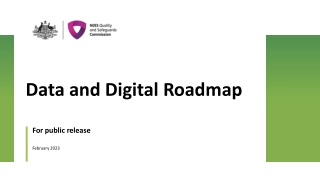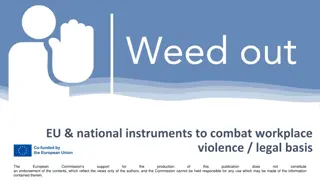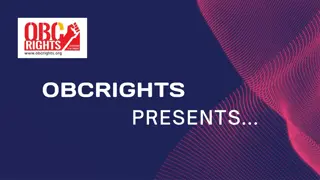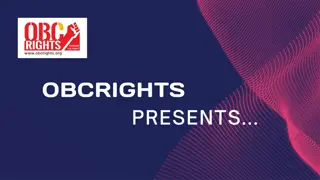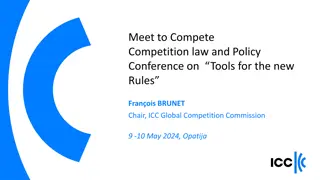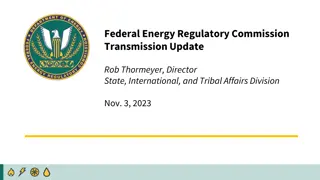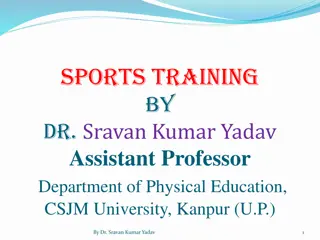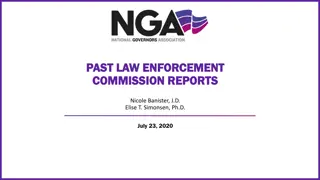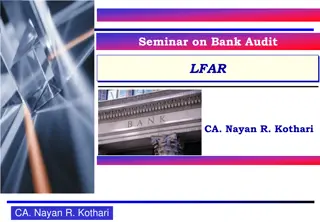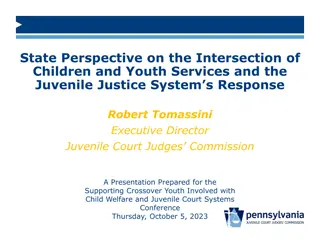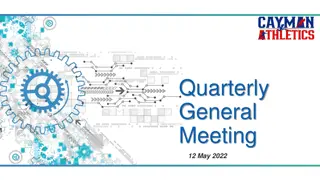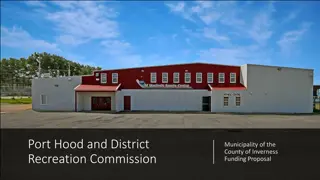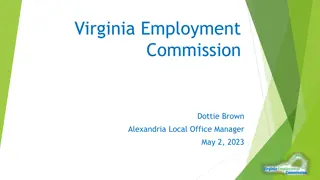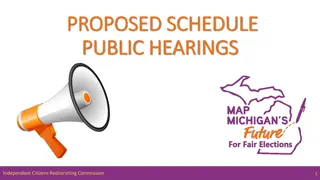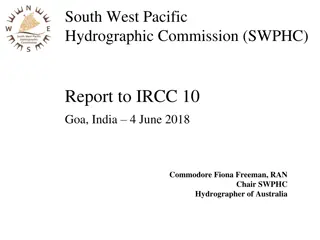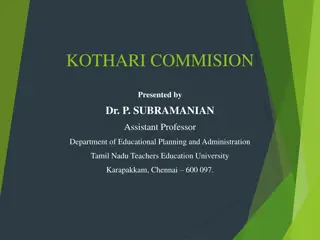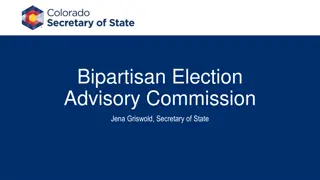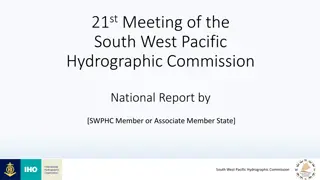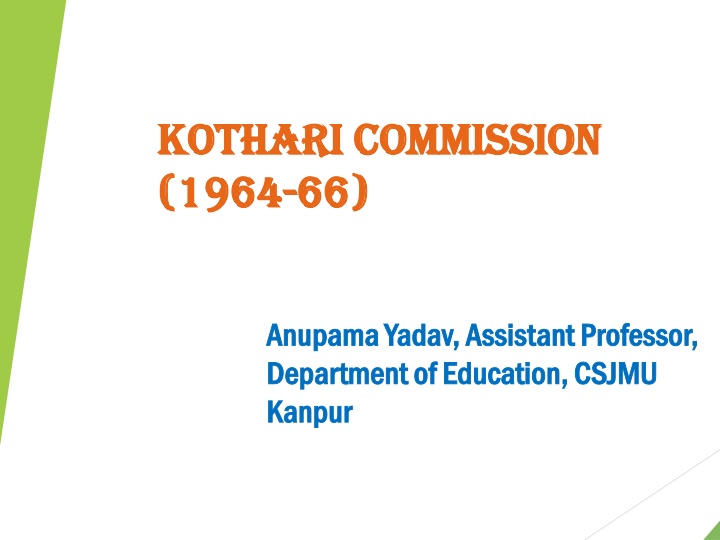
Kothari Commission 1964-66: Educational Reforms and Recommendations
Explore the Kothari Commission's educational reforms and recommendations from 1964 to 1966, focusing on aims, objectives, and the proposed changes to the national education system. Discover insights into enhancing production, fostering societal unity, and advancing democratic values.
Download Presentation

Please find below an Image/Link to download the presentation.
The content on the website is provided AS IS for your information and personal use only. It may not be sold, licensed, or shared on other websites without obtaining consent from the author. If you encounter any issues during the download, it is possible that the publisher has removed the file from their server.
You are allowed to download the files provided on this website for personal or commercial use, subject to the condition that they are used lawfully. All files are the property of their respective owners.
The content on the website is provided AS IS for your information and personal use only. It may not be sold, licensed, or shared on other websites without obtaining consent from the author.
E N D
Presentation Transcript
Kothari Commission Kothari Commission (1964 (1964- -66) 66) Anupama Yadav, Assistant Professor, Anupama Yadav, Assistant Professor, Department of Education, CSJMU Department of Education, CSJMU Kanpur Kanpur
Introduction Introduction
Aims Increaseinproductionwiththehelpofeducation. Strengthensocial&nationalunityofeducation. Establishmentofdemocraticvalues. Modernizationofnation. Developmentofsocial,moral&spiritualvalues.
Objectives Work Experience Work Experience Economic & Social development Economic & Social development Democratic Society Democratic Society Diversification of Courses Diversification of Courses Scientific & Technical education Scientific & Technical education National education system National education system
Commission Report The Educational & National Development The Educational & National Development Recommend following suggestion: Recommend following suggestion:- - Aims of National Education Administration, Finance & Planning Agriculture ,Vocational & Technical Education New Educational Structure & Standard Teacher s Education & Service condition Equalization of educational opportunities Women , Adult & Social Education Aims of National Education Administration, Finance & Planning Agriculture ,Vocational & Technical Education New Educational Structure & Standard Teacher s Education & Service condition Equalization of educational opportunities Women , Adult & Social Education
School education {ADMINISTRATION} {ADMINISTRATION} Organize National NationalBoard Boardof ofSchool School & & Indian Class1 1to to8 8(Primary (PrimaryEducation) Education)divide Organize State State Education Education Service Education Education . . All Different Different types typesof ofschool schoolshould shouldbe of of Committee Committeeof ofManagement ManagementSystem Propersupervision supervisionof ofschool school. . Separation of of supervision supervision management management. . Organize IndianEducation EducationService divideinto into2 2parts parts1 1to to5 5& &6 6to to8 8. . Service & & State State Board Service . . Class Organize Board of of School School All beabolished abolished& & instead System . . instead formation formation Proper Separation from from administration administration in in school school
Continued... {CURRICULUM} {CURRICULUM} Pre Pre- -Primary Level Primary Level Eating , clothing , cleanliness , conversation ,social etiquette ,sports,creativework. Secondary Level = Secondary Level = Mother tongue ,Hindi /English,AnyEuropean Language,Math s,Socialscience,Social study,art, experiences,socialwork,Health education,Moral& Spiritual values. Primary Level Primary Level= =Mother tongue, Math s, Physical environment, creative activity,experience,socialservice,health education,sports. Higher Secondary Level = Higher Secondary Level = 3 Language Formula , History , Geography Economics ,Logic , Psychology,sociology,Biology,art, physics,chemestry,math s,Home science,experiences,socialwork , health education. Senior Primary / Junior Secondary Level Senior Primary / Junior Secondary Level= = Mother tongue, Hindi & English , Math s , Science,Creativeactivity, art , experiences , social work , Health Education,Religious Education.
Contd. => School Contd. => School education education 3 Language Formula = Mother Tongue =national language (Hindi/English) =any modern language
Contd. => School education => TEXTBOOKS[Based on NCERT] =>TEACHING METHOD =>TEACHING METHOD => GUIDANCE & COUNCELLING Provided at Primary level Should be available in every school In-service Programme For backward & talented students State Guidance Bureau should provide training Flexible Progressive Activity oriented New Teaching Method Teaching Material Based on Psychological aspects. Lesson should be broadcast on AKASHVANI in school time as well after it. => EVALUATION [importance to internal evaluation]
Contd. => School education EXPANSION Pre-Primary Education Primary Education Secondary Education
university education =>ADMINISTRATION & =>ADMINISTRATION & ORGANIZATION ORGANIZATION => AIMS => AIMS Evaluation of previous & new knowledge Support social justice Identify exceptional students Trained students for the field of Agriculture , Medical , Science , Technical etc. Reorganizing UGC Centers of Advance Studies Inter University Council Reforming Administration system 15 to 20 members in Executive council Student Representatives Independent follow up work
Contd. University education =>CURRICULUM =>CURRICULUM => TEACHING METHOD => TEACHING METHOD 3 Years Graduation Include new subjects at graduation level. 2 Years Post-Graduation 2 3 Years for P.H.D Provide Research work Improved Teaching method Special committee to reform teaching process Time-Table No teacher allowed to leave in mid session and be given maximum 7 days leave. =>STUDENT s FEDERATION & STUDENT s WELFARE PROGRAMMES Self-study , seminar, Problem solving
Contd. University education Kothari commission (1964-66) =>MEDIUM of INSTRUCTION =>MEDIUM of INSTRUCTION => EDUCATIONAL FINANCE & => EDUCATIONAL FINANCE & PLANNING PLANNING Regional language in graduation 1965-66 English language in Post graduation 1975 1985 Teacher should be bilingual Educational expenditure 2/3rd for school & 1/3rd for Higher education. Urdu & Russian language in Higher education Increment in the amount of educational budget.
agriculture education POLYTECHNIC LEVEL SCHOOL LEVEL COLLEGE LEVEL UNIVERSITY LEVEL
Vocational & technical Education (Higher Engineering Education) (Higher Engineering Education) 25% at secondary level TET Provide electronics & instrumentation Up-to-date functioning Close those collages which are unable to function properly. More practical & experimental work New teacher s appointed for summer institutes. 50 % at higher secondary level Agriculture education at polytechnic collages. Change junior technical school to technical high school. Vocational curriculum More practical work
Science education & Research National Institute of Science Education should develop from primary class and scientific terminology be developed. Research in the field of science. Visiting Professors Course should be made as per International Level. Mechanics, Skilled Operators, Laboratory Technicians. New teachers for summer institutes. Examination Evaluation Team Work
Teachers sTaTus & service condiTion COLLEGE COLLEGE PRIMARY SCHOOL PRIMARY SCHOOL Junior scale =Rs400-25-600 Secondary edu. Senior scale =Rs400-30-650-40-800 (untrained teacher) =Rs100-150 Senior lecturer =Rs700-40-1100 After 5 years service =Rs125-250 Principal(I) =Rs700-40-1100 Secondary edu. Principal(II) =Rs800-50-1500 (trained teacher) =Rs150-280 Principal =Rs!000-50-1500 Recruit Salary SECONDARY SCHOOL SECONDARY SCHOOL =Rs250-300 UNIVERSITY UNIVERSITY Untrained graduate =Rs220 Trained graduate =Rs220-600 Recruit Salary Spokesperson =Rs400-40-800-50-950 Reader =Rs700-50-1250 =Rs400-500 Professor =Rs1000-50-1300-60-1600 Post graduate =Rs300-600
conTd. Teachers sTrucTure &service condiTion SERVICE & TECHING CONDITION SERVICE & TECHING CONDITION AIMS AIMS Pension & other allowances Equal pay of all. No service conditions RE-analysis of salary in every 5 years L.T.C in 5 year duration Curricular & Co-curricular activities Residential facility Allowance added in basic amounts of pay scale. Citizen Right Health allowance No tusion Well trained teachers Motivate for Women, even in rural areas Tribal areas
New structure of education & standard Primary Edu. (Class1-7or8) Pre-Primary Edu. (Before class 1) Juni.Primary= Class1-4 or2-5 Seni.Primary= Class 5-8 Higher Edu.(Follow. Degree) =Proffessional =UG =General Secondary Edu.(Class 8-12or9- 12) Juni.Secondary= Class 8-10or9-10 Seni.Secondary= Class11-12 =PG General Edu. =Pre & Pre-Primary School =Higher Secondary &High school =Under & Post Graduate
Contd. New structure of education & standard Duration of follow. Duration of follow. General edu.be 10 year including Primary & Secondary edu. Primary edu.7-8 years (Junior Primary 4-5 year) (Senior Primary 3 Year) Secondary edu. (2-3 Year general edu.) (1-3 Year Vocational edu.) 3 Year 1st degree course 2-3 Years 2nd degree course Establishment of Graduation School Introduce 3 year degree courses in Uttar Pradesh General edu. Primary edu. Secondary edu. No school will start from 9th class No specialization in subject in class 10th
Equalization of educational opportunities Free education from class 1-8 Free providence of text book & writing material of primary level students from class 1-5. Full free-ship to poor students in secondary & higher level. Book bank plan at secondary & higher level. Text book in libraries in he institutions. Monetary support to students. Scholarship should be provided for secondary level (State Gov.) ,for higher level (Central Gov.) Educational loan for science & technology. Conveyance facilities Proper arrangement for handicapped children. Same facilities to both backward & general category. Mobile school for gypsies & tribal areas. Equal opportunities to both boys & girls.
Women education ESTABLISHMENT Primary schools Secondary schools Separate colleges Correspondence courses Adult education programme CURRICULUM Equal level of education for both boys & girls. Home science for girls at secondary level. ECONOMIC AID For expansion of women edu. Free education up to secondary level. Scholarship Free conveyance Low cost hostels
Adult & social education NATURE NATURE Educate illiterate adults. Sustain the literacy Further facility to semiliterate adults. Continuing education ORGANISATION ORGANISATION Cooperation of teachers Cooperation of Universities Cooperation of Gram Sevika Abridge courses Mass communication ADMINISTRATION ADMINISTRATION National Board of Adult Education State Board of Adult Education Adult Education Committee N G O Special budget CONTINUTY CONTINUTY Follow-up programme Libraries etc. Short term course Correspondence courses Refresher courses
sTudenTs enrolmenT & manpower Provincial Gov. should raise more resources. Formulate a National Policy of education. Free & Compulsory education for children of 6-14 years age. Only desirous candidates for higher primary or lower secondary level. Talented students for higher education. Continuous education Expansion of education.
Merits Formulation of Principles Guidance to education planners Broad aim of education consistent Comprehensive thought Expansion of secondary & higher education Agriculture education Vocational & technical Education Adult Education Equalization Scientific education Women education
Demerits Improper defined administration Jumble structure of education Unnecessary guidance for primary level Contradict idea about of secondary education & expansion of education Defective Language policy Unnecessary establishment of senior universities & autonomous college
impact Support for 10+2+3 Policy N.C.E.R.T followed 10 year education & 3 language policy. Introduction to vocational education 3 year degree courses Support to other types of education as well Citizen right & facilities in relation with education.

